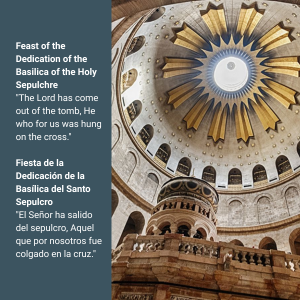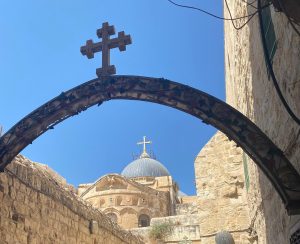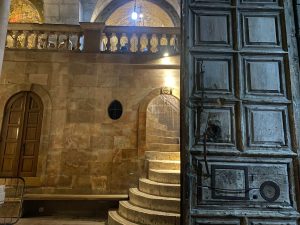On a short flight, I began speaking with a boy who was traveling alone.
At one moment in the conversation, he said with all the composure of his eight years:
– “God does not exist.”
– “Really?”
To my astonishment, he added:
– “Well, if He ever existed, He died: they killed Him.”
– “That cannot be!” I responded, with the same seriousness and conviction. “I suppose you are talking about Jesus, who died on a cross.”
– “Yes,” he said.
– “Well, He rose again,” I replied. “I live in Jerusalem, and His tomb is empty. I saw it. People from all over the world come to Jerusalem and spend hours waiting in line to see the empty tomb.”
The boy looked at me, very surprised by such news: Why had they hidden this fact from him? We did not get to speak much more because the plane landed, and his grandmother was waiting for him. But it was hard for both of us to part ways.
On July 15, the Church of Jerusalem celebrates the dedication of the Basilica of the Holy Sepulcher.
 The Basilica of the Holy Sepulcher, also known as the Church of the Resurrection, is considered the holiest place in Christianity.
The Basilica of the Holy Sepulcher, also known as the Church of the Resurrection, is considered the holiest place in Christianity.
There are thousands, perhaps millions, of empty tombs in the world, of no more interest than their archaeological or cultural documentation. How could the history of humanity change because of an empty tomb in Jerusalem?
The Empty Tomb was a witness to the resurrection of Jesus, which shattered all molds of human experience. The Apostles, in a state of shock after the crucifixion, resisted believing something so extraordinary: they were terrified when Jesus appeared among them in the Cenacle. He had to convince them: “Look at my hands and my feet, that it is I myself. Touch me and see, because a ghost does not have flesh and bones as you can see I have” (Lk 24:39). And He asked for something to eat: they offered Him a piece of baked fish. He took it and ate it in their presence. Is there anything more material than eating, chewing, swallowing?

Holy Sepulcher, Jerusalem
Thomas, who was not with them, refused to believe: Come on! “Unless I see the mark of the nails in his hands and put my finger into the nailmarks and put my hand into his side, I will not believe” (Jn 20:25). And Jesus, in accommodating fashion, appeared again and said to him: “Put your finger here and see my hands, and bring your hand and put it into my side, and do not be unbelieving, but believe” (Jn 20,27).
History is a science that relies on various sources to reveal and explain events that occurred. Certainly, data can be disregarded, distorted, or reinterpreted. Sometimes we prefer to see secret and twisted manipulations rather than accept the facts as they are, even if we do not fully understand them. From the beginning, attempts were made to change the meaning of the empty tomb.
Faith, though reasonable, is not obvious—if it were, there would be no faith: it is a freely given gift. But it is also a personal and free choice, a response. I have already chosen and have joined the line of those who go to pray at the Empty Tomb.
By Carmen Rodríguez Eyre

Entrance to the Holy Sepulcher, Jerusalem
